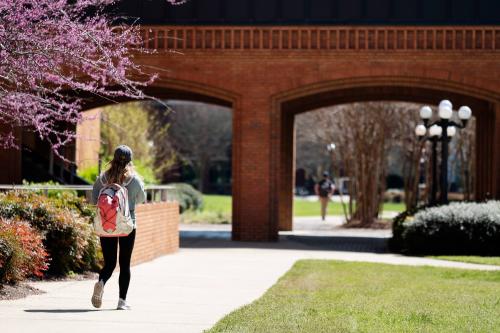The need to improve college affordability is clear, and it may have reached its moment. A college education is an investment that provides a payoff to students typically valued in the hundreds of thousands of dollars. Yet sticker prices (including tuition, room and board, and other expenses) that reach $75,000 per year at some four-year private institutions and $30,000 at public institutions are staggering, even if the cost is worth it in the long-run. Most students do not pay those prices because of the availability of financial aid. But the complexity of that system, combined with prices that may still be too high, hinders access to college, particularly for students from lower-income households.
The 2020 Democratic primary highlighted an important debate regarding the best way to increase college access. Alternative proposals were made to increase the generosity of the Pell Grant (the main current program of cash-based federal aid) and to offer “Free College,” where students would pay no tuition to attend public colleges and universities. The results of the recent election and the policy discussions taking place in its aftermath make this the right time to formally assess the strengths and weaknesses of these alternative approaches.
The purpose of this report is to evaluate the policies of doubling the maximum value of a Pell Grant or introducing a Free College program. Initially, I discuss the economics of these alternatives in a broader, conceptual framework. I follow that with a detailed analysis of data on college pricing designed to estimate the impact of these proposals on students with different levels of financial resources. How much can students afford to pay to attend college, how much do they currently pay, and how do each of these policies alter that relationship?
I mainly focus on 1,315 four-year, public and private, residential, non-profit colleges and restrict my attention to dependent students. Enrollment at these institutions totals 5.8 million, roughly the same number enrolled in public community colleges. The higher sticker prices these institutions charge exacerbate the affordability problem. I will also briefly extend the discussion to evaluate the difference between the two policies at community colleges.
My analysis leads to the conclusion that doubling the value of the Pell Grant is a better solution to increase college affordability. It is a well-targeted policy that will close the affordability gap for lower-income students, leading more of them to enroll. To be even more effective, though, it needs to be combined with further attempts to better communicate the availability of financial aid (beyond the recent FAFSA simplification). Free College is less desirable because it is poorly targeted, providing extensive benefits to higher-income students who will attend college anyway.
The role of government in college pricing
Some argue that a college education is a public good, no different than K-12 education, and it should be provided by the government for free. There is no question that society benefits from having more college graduates. For instance, a highly educated workforce enhances productivity, which benefits everyone. The problem, though, is that the typical value of a college education to an individual is also very large. Many students and their families are willing and able to make that investment on their own, making it unnecessary to provide it to everyone for free.
A better solution is to subsidize higher education for those who would not otherwise be able to afford it. The financial aid system facilitates such a process by estimating how much a student can afford to pay. The level of subsidy should close the gap between that amount and the amount colleges charge.
What does affordable mean?
In our current system, paying for college is often comprised of three distinct elements: direct cash payments from students and their parents, loans, and student work. How much of each can a student’s family afford? In this analysis, I will define affordability based on the sum of a calculated “affordable” direct cash payment (which I will describe in greater detail below) and reasonable expectations regarding loans and student work.
In terms of loans, it is reasonable to expect that individuals will take on some debt because going to college is an investment with high returns. Asking students to take on limited debt does not seem like an excessive burden. For the purposes of this exercise, I will assume that the maximum federal student loan of $5,500 in a student’s freshman year satisfies this concept.
It also seems reasonable to expect students to fund their education with limited paid employment, through a job in the federal work-study program or in the private sector. It would be difficult, though, to expect excessive work, which could be counterproductive to the educational enterprise. In this case, I assume a value of $2,500 over the course of an academic year, which represents 30 weeks of work at 7 hours per week at around $12 per hour.
The difficulty really lies in determining the level of cash payments that students and their families can afford. The concept is straightforward; families with control over greater financial resources can afford to pay more. Note that this includes both income and assets.
It is much more complex in practice, though. Should all assets count, including home equity and retirement savings? When a family has multiple children in college at the same time, is there a limit to how much of their income should go to higher education expenses that year? And how do we incorporate financial resources from divorced parents?
Addressing these and other thorny issues go far beyond the scope of this exercise. Yet our current financial aid system incorporates all of them. Formulas exist that translate families’ financial characteristics into a measure labeled the “expected family contribution (EFC).” Perhaps it is not an ideal system, but the EFC is intended to capture what a family can afford to pay for college. For the purposes of this exercise, I will use this measurement, overlooking the complexity in deriving it and the merits of its assumptions.
A standard measure in the financial aid world is “net price,” which is typically reported as the difference between the cost of attendance and total grant aid. It is identical to the sum of the amount paid through cash payments made by the family, loans, and student earnings. I define the “affordable net price” to represent the sum of the calculated EFC, a reasonable loan, and reasonable earnings. An institution is affordable to a student if the affordable net price is less than the actual net price that they are asked pay.
Based on the assumptions I have made, a student from a low-income family with a $0 EFC could still afford to pay a net price of $8,000 (the $5,500 loan and $2,500 in earnings) to a particular institution. If the net price for this student at an institution is at that level or below, it is declared to be affordable (an approach similar to one taken by the National College Attainment Network). As a family’s financial resources and EFC rises, its affordable net price will rise as well.
Assessing the Affordability of College
College affordability differs for students with different financial resources. I use the 2016 Survey of Consumer Finances (SCF) to calculate the 10th, 25th, 50th, 75th, and 90th percentiles of family income (pre-tax) and basic asset holdings of families with children between the ages of 13 and 17 (approaching college age). I then apply an algorithm I designed to approximate the way institutions use family finances to estimate EFC. These calculations assume that the student has no other siblings enrolled in college. I combine this estimated EFC for students at each percentile with the assumed funds available from loans and student work to calculate the affordable net price.
To estimate how much colleges would actually charge these students, I rely on data from institutions’ net price calculators. In 2008, amendments to the Higher Education Act required that, starting in 2011, institutions must offer these tools that provide pricing estimates based on family finances and other information. To estimate the actual net price for families, I entered the income and asset values associated with each percentile (derived from the SCF data) into individual colleges’ net price calculators. Since these net prices refer to an individual family with a specific set of financial characteristics, I label this statistic the “individual net price.”
Aside from financial information, these tools often ask for other data about the applicant. I answered these questions using a standard set of assumptions (dependent student, married parents, living on campus, no siblings, and in-state residence). For institutions that provide merit awards, I used the 75th percentile SAT/ACT score at the institution, available from the Integrated Postsecondary Education Data System (IPEDS), and a 3.67 GPA. This is a high GPA, but I chose it to allow for a reasonable chance of a merit award at most institutions. All other requested information, if required, was based on judgment using plausible values.
The task of obtaining estimates in this way was sufficiently cumbersome that I restricted my attention to a random sample of 50 four-year, residential colleges and universities in each of four categories (200 total). The categories include: (1) public flagship and other research-intensive public universities (labeled “R1,” as defined in the Carnegie Classification system), (2) other public institutions, (3) private institutions with large endowments (greater than $150,000 per student), (4) other private universities. The attributes of each category of institution are sufficiently distinct that they warrant separate analysis. All statistics reported represent means within each set of institutions; considerable variation across institutions within categories may exist.
The results of this analysis are reported in Table 1 and Figure 1. In Table 1, the highlighted cells reflect individual net prices that exceed the amount the students can afford. Students at the 10th percentile of the income and asset distribution (with family income of $19,900) can afford to pay $8,000, including a $5,500 student loan and $2,500 in student earnings. This family cannot afford to pay anything directly based on existing financial aid formulas. The 25th percentile family (income of $36,600) can afford to pay just a little more, $8,600.
Table 1: College Affordability, by Type of Institution and Level of Income and Assets
| Income/Assets |
Expected Family Contribution (EFC) |
“Affordable Net Price” |
Individual Net Price |
|||
| Public Flagship/R1 |
Other Public |
High Endowment Private | Other Private | |||
|
10th Percentile (income = $19,900, assets = $6,100) |
$0 | $8,000 | $12,100 | $12,000 | $9,300 | $19,900 |
|
25th Percentile (income = $36,600, assets = $22,800) |
$600 | $8,600 | $14,300 | $13,300 | $10,700 | $21,600 |
|
50th Percentile (income = $70,100, assets = 98,500) |
$11,700 | $19,700 | $21,400 | $18,700 | $18,100 | $25,800 |
|
75th Percentile (income = $119,300, assets = $259,300) |
$31,300 | $39,300 | $25,700 | $19,700 | $33,500 | $32,800 |
|
90th Percentile (income = $210,300, assets = $856,900) |
$83,100 | $91,100 | $26,400 | $20,000 | $58,000 | $35,600 |
Notes: Assets include non-retirement investments, cash in the bank and home equity. Income is total family income before taxes. The “affordable net price” is calculated based on an algorithm designed to closely match the way institutions estimate expected family contributions (EFC) applied to income and asset data obtained from the 2016 Survey of Consumer Finances for families with children approaching college age (13 to 17). It is defined as: estimated EFC + $5,500 (Federal Student Loan) + $2,500 (Student Work). The “individual net price” is calculated as the mean net price obtained from randomly selected online net price calculators from 50 institutions in each school category (all of which are four-year, residential institutions). The highlighted cells represent deficits between what students are expected to pay and what they can afford to pay.
Students from these lower-income families are charged considerably more than they can afford at all institutions other than highly endowed private institutions. Public institutions charge these students between $12,000 and $14,000, exceeding the amount they can afford by roughly $4,000-$6,000, as shown in Figure 1. Private institutions without large endowments typically charge lower-income students considerably more than that (although considerably less than their sticker prices). Without funding from the state or from their endowments, these institutions simply do not have the resources to enroll lower-income students at affordable prices.
Middle-income and higher-income students fare better in this system. At all institutions other than the less well-endowed privates, they face prices that are largely within their means. In fact, all types of institutions, and particularly public ones, charge students from higher-income families considerably less than they can afford.
The notion that college is generally affordable for the middle-class may seem counterintuitive to many. One potential reason for this is that “affordable” is defined here as “feasible.” It still may not be easy for these families to pay that price. Alternatively, the current formulas used by the financial aid system to determine how much a family can afford to pay may result in estimates that one considers to be too low. This is certainly possible, but these calculations also ignore available tuition tax credits of up to $2,500 through the American Opportunity Tax Credit, which largely benefits students from middle income families.
Assessing Proposals to Improve College Affordability
This analytical framework is useful for analyzing the main college affordability proposals offered during the 2020 Presidential campaign. One is Joe Biden’s initial proposal to double the value of the Pell Grant from its current maximum value of $6,345 to $12,690. Another is Bernie Sanders’ College for All plan, which he introduced in the Senate in 2019 (bill S. 1947); it would eliminate the cost of tuition at public colleges and universities (note that it does not include other expenses, like room and board). The 2020 Democratic Party Platform included a combination of these proposals, doubling the Pell Grant and modifying College for All by restricting free tuition to students from families with incomes under $125,000.
A critical element of College for All is that students would still be eligible for other forms of financial aid, including Pell Grants. Free tuition does not mean no cost – students still need to pay for living expenses. More traditional forms of financial aid could cover those costs. In the calculations I provide here, I have assumed that all other forms of financial aid would remain available if the College for All program were implemented.
Table 2 simulates the affordability gaps under the alternative proposals along with the gaps that exist in the current system. This table focuses on public flagship/R1 institutions because College for All only provides free tuition at public institutions; and pricing differences between flagship/R1 institutions and other public institutions is small. In forecasting the impact of these proposals, I assume a cost of attendance at public flagship/R1 institutions of $27,100 and tuition and fees of $11,000, based on IPEDS data from the 2018-19 academic year.
Table 2: Simulated Net Prices and Affordability Gaps under Alternative Policies at Public Flagship/“R1” Universities
| Income/Assets | Affordable Net Price | Current Net Price | Double Pell | College for All 2019 |
Double Pell and College for All |
|
Individual Net Price |
|||||
| 10th Percentile | $8,000 | $12,100 | $5,800 | $1,100 | -$5,200 |
| 25th Percentile | $8,600 | $14,300 | $8,600 | $3,300 | -$2,400 |
| 50th Percentile | $19,700 | $21,400 | $21,400 | $10,400 | $10,400 |
| 75th Percentile | $39,300 | $25,700 | $25,700 | $14,700 | $14,700 |
| 90th Percentile | $91,100 | $26,400 | $26,400 | $15,400 | $26,400 |
|
Affordability Gap |
|||||
| 10th Percentile | -$4,100 | $2,200 | $6,900 | $13,200 | |
| 25th Percentile | -$5,700 | $0 | $5,300 | $11,000 | |
| 50th Percentile | -$1,700 | -$1,700 | $9,300 | $9,300 | |
| 75th Percentile | $13,600 | $13,600 | $24,600 | $24,600 | |
| 90th Percentile | $64,700 | $64,700 | $75,700 | $64,700 | |
Notes: The simulated affordability gap is defined as the difference between the affordable net price and the simulated individual net price incorporating each policy. All calculations are rounded to the nearest $100 and are based on a cost of attendance at four-year, residential, public flagship/R1 institutions of $27,100 and tuition and fees of $11,000 (estimates obtained from IPEDS data for the 2018-19 academic year). The results reported in the final column incorporate the provision that free tuition is only available for students under $125,000 in family income.
The results of this analysis show that doubling the Pell Grant eliminates the affordability gap for students from lower-income families. A gap of $1,700 still remains for middle-income families, who would not benefit from enhanced Pell Grants. Again, though, these students are common beneficiaries of the $2,500 tuition tax credit that is not incorporated into these calculations. For the most part, students throughout the income distribution would face net prices that they could afford (with higher income students still able to afford considerably more than they are charged).
Under College for All, the affordability “gap” turns into a surplus for students from lower-income families. They would pay a net price of $1,100 (10th percentile) to $3,300 (25th percentile) under this system. These students could significantly reduce the amount that they need to borrow or work to pay for college. The affordability surplus, though, faced by students at the highest income levels would also increase. Charging lower prices to students who already can afford to attend college will not alter their college-going behavior. This is a poorly targeted approach to make college more affordable.
The proposal contained in the platform of the 2020 Democratic National Committee is overly generous. Doubling the Pell Grant and eliminating tuition provides benefits that would be difficult to justify even for lower-income students. No loans or student employment would be necessary and an additional $3,200 to $5,300 in benefits would be available that either would go unused or it could be paid out as a rebate. Limiting the benefit to higher income students helps, but the excessive benefits this proposal provides make it difficult to support.
At community colleges, the policies analyzed really are not that different from each other. My calculations using IPEDS data indicate that the 2018-19 median annual cost of attendance (including books, transportation, and other expenses) these institutions charge for state residents living with their family is $9,700; 55 percent of their students currently receive a Pell Grant. Even more students would become eligible for Pell grants if their value were doubled. At a maximum value of $12,690, those grants would cover a large or complete share of the cost for many of them. Free College would provide additional benefits to more community college students, but not many.
Other Considerations
One frequently raised criticism of increasing the generosity of the Pell Grant is that institutions will just alter their own policies in ways that limit its benefit. The Bennett hypothesis, for instance, claims that institutions will simply increase their sticker prices to capture the additional federal funding. Alternatively, institutions could reduce their own funding for financial aid. Yet past research does not find strong support that institutions act in this way. For public institutions, though, the calculations reported here indicate a way to prevent that. Since doubling the Pell Grant closes the affordability gap at these institutions, they would have the funds available to meet a student’s full financial need (i.e. charge them no more than their affordable net price). They could be required to do so, which would prevent them from diverting those funds.
The complexity of the financial aid system could limit the value of doubling the Pell Grant.
Determining the ultimate price that students will pay to attend college requires students to complete complicated financial aid forms. Recent legislation enacted to simplify the FAFSA form used to determine Pell Grant eligibility will help, but a final determination of net price also depends on the financial aid offered by the higher education institutions themselves. This is a legitimate concern that needs to be addressed if we are to pursue this solution.
One advantage of a Free College plan is that its value to students automatically adjusts to tuition increases over time. Doubling the dollar value of the Pell Grant does not do so, which would lead its value to erode over time. Indexing its value to account for inflation is necessary to maintain affordability going forward.
An additional effect associated with Free College is that it will devastate the finances of those private colleges with smaller endowments. These institutions compete directly with public institutions. They would have tremendous difficulty recruiting students if the cost of attending public institutions fell by $11,000. Many of these institutions already face significant financial constraints. Free College represents an existential threat to them.
Discussion
The book, Hard Heads, Soft Hearts, came out when I was in graduate school. It was written by Alan Blinder, a professor of mine at the time. He made the argument that it is difficult to find policies that are both economically efficient and promote social equity; when we find such policies, we should support them strongly. It was a valuable lesson then and it is advice that we should continue to follow today.
Doubling the value of the Pell Grant is such a policy. It corrects a market imperfection, encouraging college attendance among students who may otherwise choose not to go because they cannot afford it (efficient). It does so by specifically targeting students from lower-income families (equitable).
Free College supports neither goal. It provides subsidies to students whose behavior will be unaffected (inefficient); those students come from higher-income families (inequitable). Policies that fail both tests should not be supported. Overall, doubling the value of the Pell Grant is a better policy approach.
Acknowledgements: The author thanks Emily Cloonan for outstanding research assistance and Sam Heep, Melissa Kearney, Robin McKnight, and Sarah Reber for helpful comments. Much of the content of this report is based on Levine’s forthcoming book, A Problem of Fit: How the Complexity of College Pricing Hurts Students – and Universities. (University of Chicago Press).
Phil Levine is founder and CEO of a non-profit organization, MyinTuition Corp., that provides simplified financial aid calculators to colleges and universities. Research that he performs forecasting students’ college costs relies on MyinTuition’s underlying algorithm. He did not receive financial support from any firm or person for this article or, other than the aforementioned, from any firm or person with a financial or political interest in this article. Other than the aforementioned, he is currently not an officer, director, or board member of any organization with an interest in this article.







